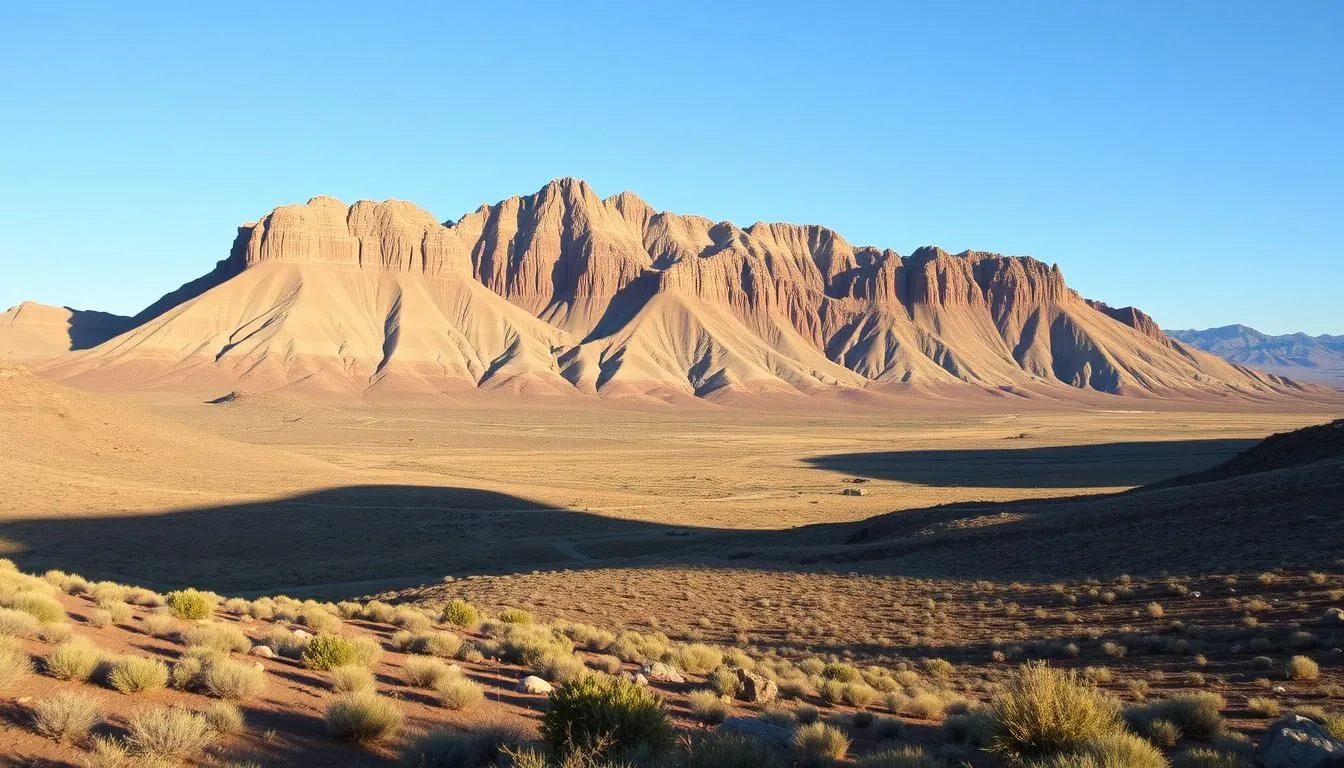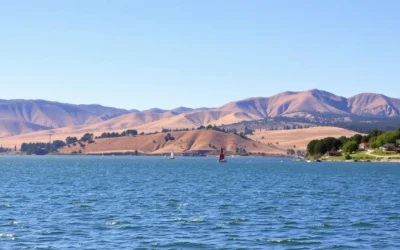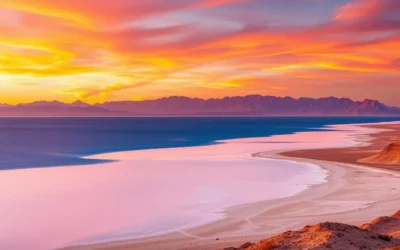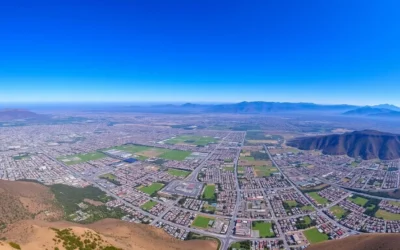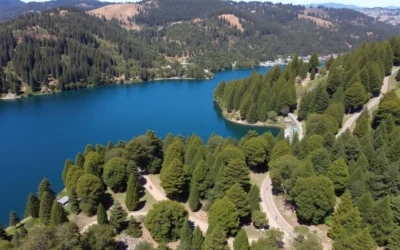✓ Accommodations ✓ Flights ✓ Rental Cars
Imagine standing in an area that was once the site of one of North America’s most massive volcanic eruptions. The Volcanic Tablelands, located just north of Bishop, California, span approximately 350 square miles, offering a unique landscape shaped by time.
You’ll find yourself in a geological wonderland, where the earth’s history is visible in the volcanic formations and ancient petroglyph sites. This place is a haven for outdoor enthusiasts, with activities ranging from rock climbing and hiking to fishing and photography.
As you explore this fascinating region, you’ll uncover the secrets of the earth’s past and experience the natural beauty that makes the Volcanic Tablelands a must-visit destination in the Eastern Sierra.
The Geological Marvel of Volcanic Tablelands
The geological marvel of Volcanic Tablelands is a result of a cataclysmic event that reshaped the landscape. This vast and unique terrain is a result of volcanic activity that occurred hundreds of thousands of years ago.
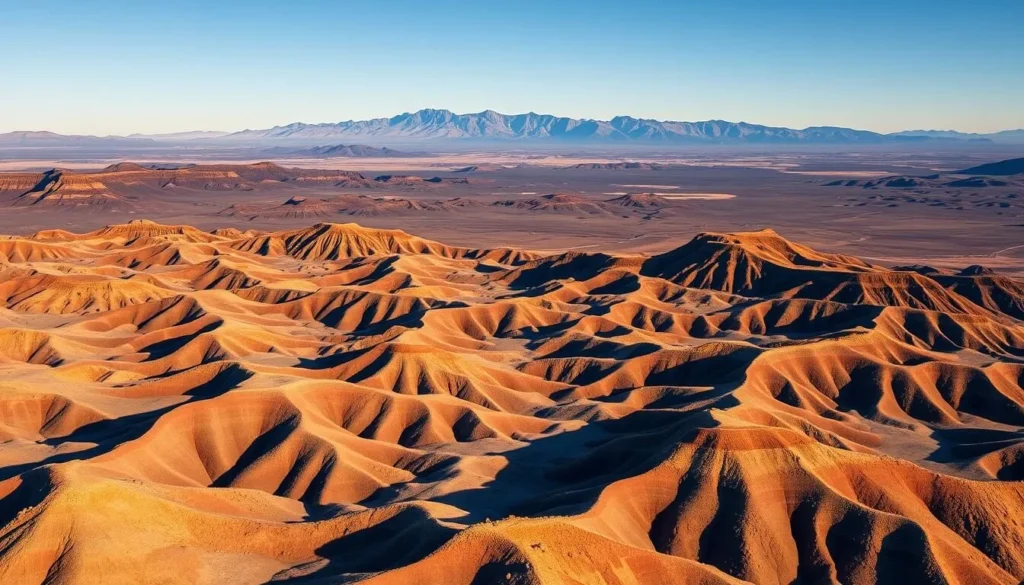
Formation of the Bishop Tuff
The Bishop Tuff is a significant geological formation resulting from the massive eruption that created the Long Valley Caldera. This eruption was so powerful that it sent ash as far as Nebraska and Kansas, over 1,000 miles away. The ash flows from this eruption cooled and welded together, forming the tuff deposits that you can explore today.
As you examine the tuff deposits, you’ll notice the varying densities and colors, a testament to the intense heat that welded the ash particles together. This geological process created the unique landscape of the Volcanic Tablelands.
Long Valley Caldera Eruption
The Long Valley Caldera eruption, which occurred approximately 760,000 years ago, was a cataclysmic event that had a profound impact on the region. The eruption was so massive that it caused the ceiling of the magma chamber to collapse, creating a depression about 10 by 20 miles in size.
| Event | Description | Impact |
|---|---|---|
| Long Valley Caldera Eruption | Massive volcanic eruption | Created a 10 x 20 miles depression |
| Ash Flows | Scorching ash flows racing across the landscape | Vaporized everything in their path, forming tuff deposits |
| Post-Eruption | Water and sediment ponding in the Long Valley Caldera | Created a massive lake that eventually breached, forming the Owens River |
For approximately 600,000 years after the eruption, the Long Valley Caldera filled with water, creating a massive lake. Eventually, about 100,000 years ago, the lake breached its southeastern rim, giving birth to the Owens River. The aftermath of this eruption is still visible today in the Volcanic Tablelands.
Exploring Ancient Petroglyph Sites
As you venture into the Volcanic Tablelands, you’ll uncover a rich tapestry of ancient petroglyphs that tell stories of the past. The region is dotted with numerous sites, each offering a unique glimpse into the lives and cultures of the people who once called this area home.
Chidago Canyon Petroglyphs
The Chidago Canyon Petroglyphs are a significant site within the Volcanic Tablelands. To explore these petroglyphs, you’ll need to hike through the canyon, where the ancient carvings are etched into the rocks. The designs include a variety of patterns and figures, showcasing the artistic and cultural expressions of the region’s past inhabitants.
Fish Slough Petroglyph Area
Located within the Fish Slough area, this petroglyph site is another must-visit destination. The site features a range of petroglyphs, including some that are quite distinct from those found elsewhere in the Tablelands. As you explore the area, you’ll be struck by the unique rock art and the natural beauty of the surroundings.
Rosetta Stone and Kitchen Rock
Two of the most fascinating petroglyph sites in the Volcanic Tablelands are the Rosetta Stone and Kitchen Rock. The Rosetta Stone petroglyph site requires some detective work and hiking to locate, but the reward is well worth the effort. The site features distinctive hand prints and concentric circles with radiating lines, carved by ancient artists. Kitchen Rock, another significant site, offers unique rock art that differs from other sites in the region.
- You’ll need to do some detective work and a bit of hiking to locate the fascinating Rosetta Stone petroglyph site.
- When you discover Kitchen Rock, you’ll be rewarded with unique rock art that differs from other sites in the region.
- The journey to these more remote sites offers not just archaeological treasures but also the thrill of exploration.
Hiking Through Volcanic Landscapes
Exploring the Volcanic Tablelands on foot allows you to witness the raw power of geological forces that have shaped this landscape. As you hike through the area, you’ll be surrounded by unique landforms and fascinating geological features.
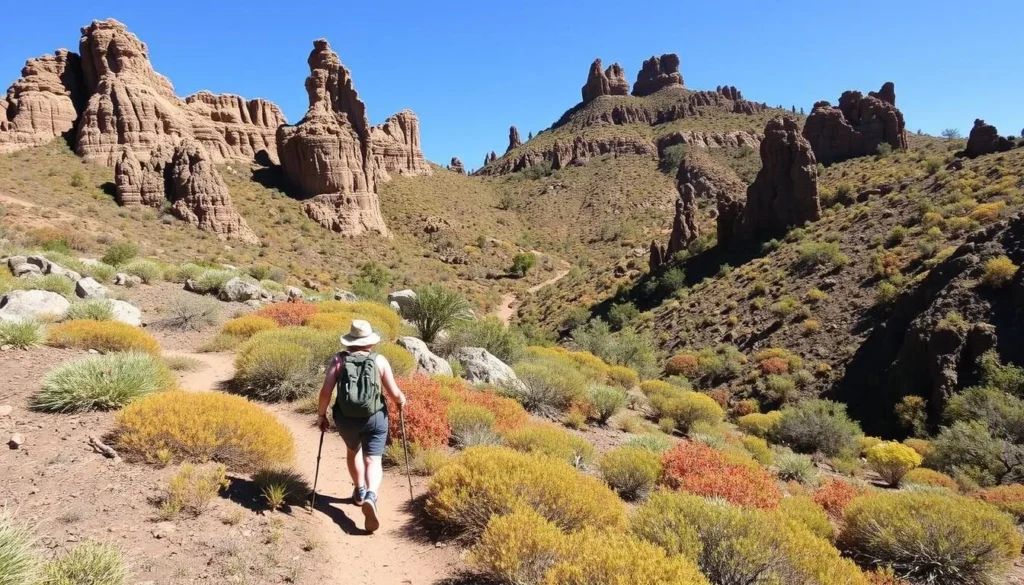
Red Canyon Trails
The Red Canyon Trails offer a unique hiking experience, with trails that take you through a landscape of volcanic rock formations. The trails wind through the canyons, providing stunning views of the surrounding landscape. You’ll notice the unique rock formations, including the characteristic tuff deposits.
Fossil Fumarole Formations
As you make your way through the Volcanic Tablelands, you’ll come across the fascinating fossil fumarole formations. These distinctive bumps, rising 10-20 feet above the surrounding tableland, are a testament to the area’s volcanic history. The tuff around ancient gas vents was cemented with minerals, making these formations more resistant to erosion.
- You’ll be amazed by the fossil fumarole formations that dot the landscape, appearing as distinctive bumps rising 10-20 feet above the surrounding tableland.
- When hiking the trail to these geological wonders, you’ll notice how the tuff around ancient gas vents was cemented with minerals, making these formations more resistant to erosion than the surrounding rock.
- The most spectacular formations are the “joint rosettes” or “rock tulips,” where columns of tuff curve downward to a common point, creating flower-like patterns in the stone.
- As you explore these unique volcanic features, you’ll enjoy impressive views of both the Sierra Nevada and White Mountain ranges, offering perfect backdrops for photography enthusiasts.
Owens River Gorge Adventures
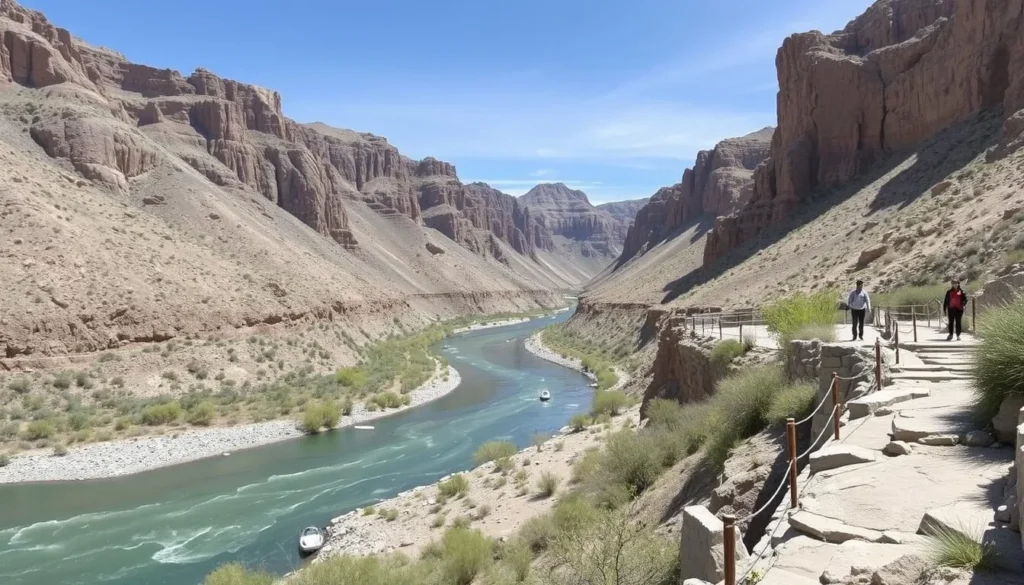
As you venture into the Owens River Gorge, you’ll discover a world of adventure and natural beauty. The Owens River flows from Lake Crowley, crossing the Volcanic Tableland via the gorge, making it a unique location for various activities.
Rock Climbing Opportunities
The Owens River Gorge is renowned for its exceptional rock climbing opportunities. Climbers can explore the gorge’s rugged terrain, with routes for various skill levels. The gorge’s rock formations provide a challenging and exciting experience for climbers.
To make the most of your climbing adventure, ensure you have the necessary equipment and knowledge of the area. The gorge is accessible via roads and trails, with directions available online.
Fishing in the Gorge
The Owens River Gorge offers excellent fishing opportunities, with cold, clear waters supporting a healthy population of wild brown and rainbow trout. The river features pocket water, riffles, and deep pools carved through volcanic rock, creating diverse habitats for fish.
When fishing, be aware of the fluctuating water levels due to the operation of the Los Angeles Department of Water and Power’s hydroelectric facilities. It’s essential to check flow reports before your visit. For the best experience, use lightweight tackle and flies that imitate the abundant insect life, including midges, caddis, and mayflies.
Volcanic Tablelands, California: Best Things to Do for Photography Enthusiasts
The Volcanic Tablelands provide endless opportunities for photographers to capture stunning images. With its unique landscapes and dramatic backdrops, this destination is a paradise for photography enthusiasts.
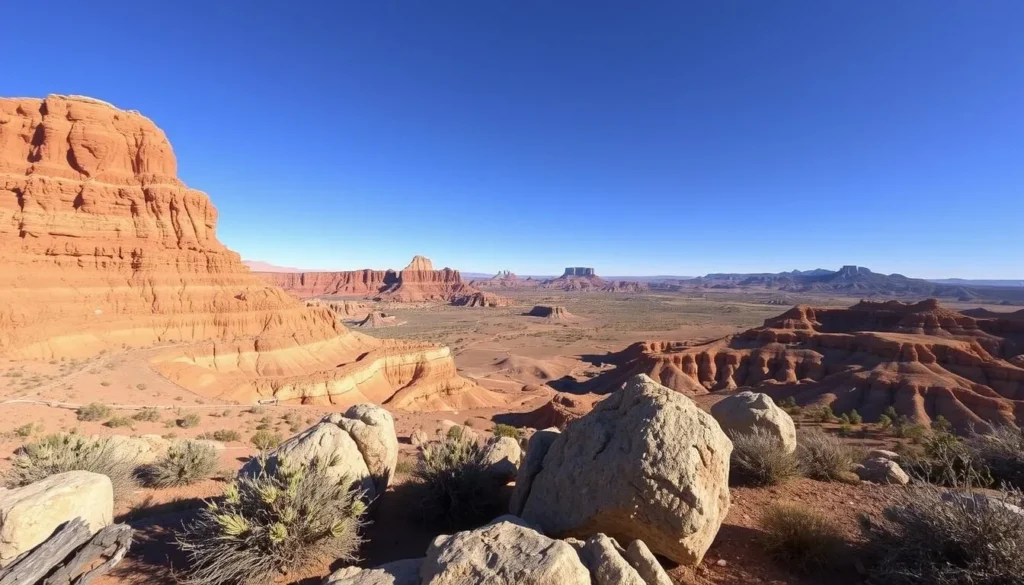
Sunrise and Sunset Viewpoints
Capturing the sunrise or sunset at the Volcanic Tablelands is a must for any photographer. The changing light during these times offers a kaleidoscope of colors, enhancing the natural beauty of the landscape. To make the most of your photo shoot, plan your visit during the golden hour when the soft, warm light adds depth and character to your images.
- Arrive early to secure the best vantage points.
- Experiment with different angles and compositions.
- Take advantage of the changing light to capture a variety of shots.
Capturing the Sierra Nevada Backdrop
The Sierra Nevada mountain range provides a breathtaking backdrop for your photography endeavors. The contrast between the relatively flat volcanic tablelands in the foreground and the jagged, snow-capped mountains in the background creates dynamic compositions. Visit at different times of the day to capture the changing light and its effects on the landscape.
On clear days, the visibility is at its best, allowing you to capture the full grandeur of the mountain range. The views are simply stupendous, making it an ideal location for landscape photography.
Planning Your Visit to Volcanic Tablelands
To make the most of your visit to the Volcanic Tablelands, it’s essential to be prepared. The area’s unique geological features, such as the tuff formations and pumice deposits, are a result of the massive eruption that formed the Long Valley Caldera 760,000 years ago. When exploring the Fish Slough petroglyph sites, remember to bring plenty of water, sun protection, and sturdy hiking shoes to navigate the rough volcanic terrain.
For the best experience, stop by the White Mountain Ranger Station or the Bishop Visitor’s Center to obtain maps and current information about road conditions and site accessibility. A high-clearance vehicle is recommended to access many parts of the Tablelands, especially after rain. Be respectful of the cultural heritage sites, and avoid touching the petroglyphs to preserve them for future generations.
Plan your trip during spring or fall for comfortable weather conditions, and consider spending at least 2-3 days to fully appreciate the diverse attractions. With a good camera and the right mindset, you’ll be able to capture the beauty of the Volcanic Tablelands and create lasting memories.
The above is subject to change.
Check back often to TRAVEL.COM for the latest travel tips and deals.
